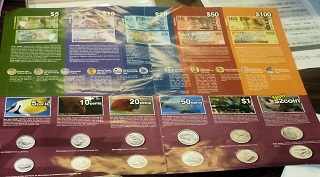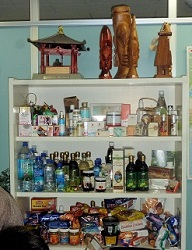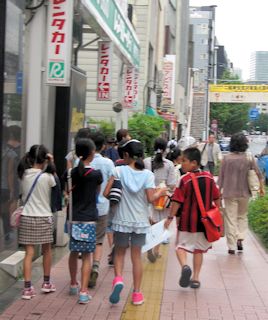Now, the introduction of the Republic of Fiji.
Lucky to the school children, Iki-san's explanation was so easy for them
to understand with plain documents and a screen.
|
|
| Country Name |
| Republic of Fiji |
| Capital |
| Suva, Viti Levu Island |
| Official Language |
| English, Fijian, Fiji Hindi |
| Independence |
| October 7th, 1987 |
| Area |
Total: 18,270 ㎢
almost the same with Shikoku, Japan |
| Islands |
330
largest: Viti Levu (half of Shikoku)
2nd largest: Vanua Levu |
| Population |
858,038 (2012)
around 1/15 of Tokyo |
|
|
|
Distance from Japan: about 15 hours by plane
Currency: Fijian dollar (FJD)

Time Difference: Japan + 3 hours, + 4 hours during the summer saving time
Electricity: 240 volt, 50 cycle. Power generation mainly by oil and water
Tip: Not Necessary
Foreign Visitors (2011): 675,050 (9,616 from Japan)
Sports: Rugby, Soccer
Religion: Christianity (Fijian), Hindu (Indian)
News: in English. Most of TV programs, newspapers and documents of public offices are in
English. |
"Any questions or anything unclear?"
Iki-san stopped her presentation and asked the children, making sure if
they understood what she explained.
Their reaction was like a locomotive starting from a station: move slowly at the start, become speedy little by little, get a high speed, and finally run at full speed to no end.
At first, 2 girls raised their hands slowly and even timidly.
 "What fruits grow up in Fiji?" "What fruits grow up in Fiji?"
"They are pinapples, papayas, mangos, cacaos, star fruits, bananas,
watermelons, sugar canes, ....."
"What food do they eat?"
"Coconut, fish, rice, taro, sweet potato, cassava and breadfruit are
the main components in local Fijian dishes..... And don't forget Fiji water.
It is famous in the world."
After a while, everybody wanted to be called on. And finally Iki-san said,
"Sorry it is about time. So, two more questions, please."
DVD was shown during the time. It must surely have helped the children's
understanding deeper.
To summarize other Q & A as follows;
Q: "What do most of the Japanese travel to Fiji for?"
A: "Many go there for honeymoon, diving..... You will notice what
a beautiful sea there."
Q: "What about prices?"
A: "In general most goods in Fiji are inexpensive. Around one fourth
or one fifth of them in Japan."
Q: "How well is security maintained there?"
A: "Safe! The people are "Bula!" and always smiling."
Q: "When do they come of age and when can they get a driver's licence?"
"Wait. I'll ask another staff." Iki-san got out of the room,
and in a minute got back.
A: "Their coming of age is 21 and they can drive a car from the age
of 17."
Q: "What is the role of the Embassy?"
A: "Well, important question and difficult to answer. One of the roles
is to take care of the Fijians living in Japan. There are about 150 people
here. The ambassador stands proxy for the President of Fiji. ....."
Q: "What is an average height and weight of Fijians?"
A: "They are big, so it is one of the reasons their rugby is strong.
180 cm high and 100 kg heavy are an average."
- - - - -
The lecture lasted nearly 2 hours until 15:00.
It must have been so impressive to all the children and will hopefully
be helpful to their future.
It was still a dull sky outside, but no rain.

They came back to the Urayasu Int'l Center just after 16:00 and dismissed,
with everybody saying, "Bula! Moce (Hello! Goodbye)."
|